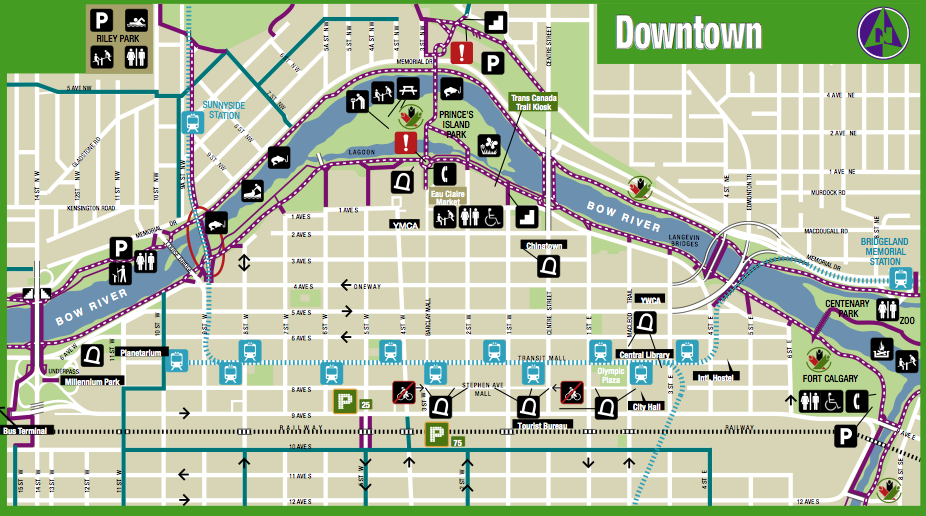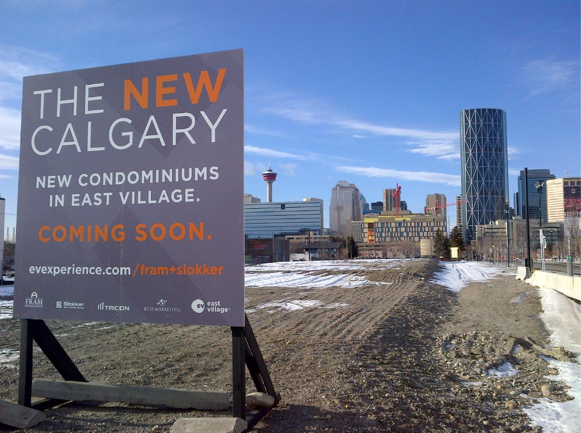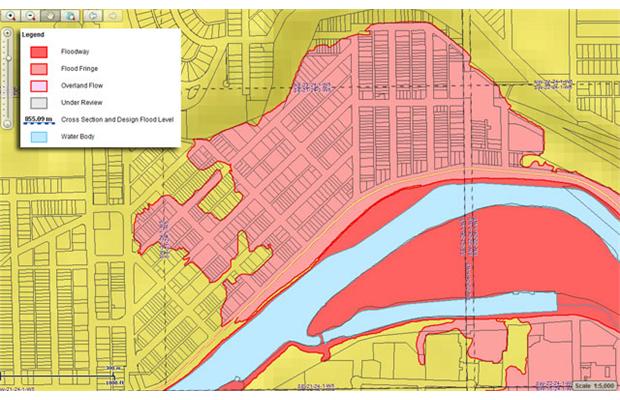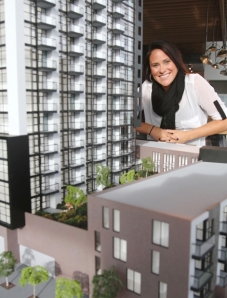25 fun things to do this November in Calgary and surrounding area! This month, join in the city’s first Beard Run (even if you don’t have a beard), bring your dog to a mid-month Christmas market, find out what a cruffin is and throw some teddies at a Hitmen game. Some many things to do – so little time! Of course do not forget to take the time to recognize Remembrance Day. Our Team’s real estate office is just steps from the Memorial Drive row of crosses. We have had the pleasure of joining in the Remembrance Day event the past several years at this location and it is truly special and not to be missed! http://www.avenuecalgary.com/Things-to-Do/25-Best-Things-To-Do-This-November-Calgary-2016/

East Village
Cyclists applaud council decision
Downtown bike network gets one- year test drive
Click Here to get an interactive map and find out the routes or Click Here to view the .pdf of the community maps with routes from the city of Calgary.

When commuter cyclists have safe downtown routes of their own on 8th Avenue, 12th Avenue and 5th Street, they’ll be able to thank one of their own for helping shift the council vote into their favour.
Jenn Turcott was one of many avid, year-round cyclists who took the day off work earlier this month to urge a council committee to make her daily ride to the office safer with barrier-separated bike lanes.
She urged councillors to consider that Beltline residents like her rely on the roads more often than suburban motorists. She fretted over a debate in which “fear trumps reason.”
Turcott may not have persuaded many council members, but her boss was clearly listening and understanding – Coun. Andre Chabot, who has long employed her as a constituency assistant.
“Hearing her concerns and some of the close calls she had, certainly opened my eyes to the challenges a cyclist who wants to commute on a regular basis has,” he said.
Chabot split off from the suburban conservative councillors he normally votes with to support 5.6 kilometres of new separated bike lanes as a one-year trial starting next year.
They also OK’d an end to the ban on daytime riding along the Stephen Avenue pedestrian mall – a decision many downtown retailers urged council not to make.
Council voted 8-7 in favour of nearly all the “cycle tracks” that city planners recommended, although they rejected a proposed route in a traffic lane on 1st Street S. E., one of the core’s busiest routes.
Cycling advocates hailed the major leap forward for pedalling options into the core. Transportation planning bureaucrats shared celebratory handshakes outside city chambers, after months of fierce public criticism of their ideas and questioning of their data.
“Some people are skeptical. It’s new for them – lots of questions,” said transportation engineer Blanka Bracic, who was targeted personally on social media by a frustrated councillor last month. “And for others, they’ve seen it in other places and can’t wait for it to start here.”
Without 1st Street S. E., the separated lane network is left without a north-south connector in east downtown, but two close together at 5th Street and the existing on-street trail at 7th. But the smaller trial is $ 2 million cheaper – now costing $ 7.5 million for the pilot project, or $ 11.8 million if it’s made permanent.
Council instructed transportation managers to find ways to further shave costs off the pilot project.
This is the biggest investment in infrastructure for cyclists since the Peace Bridge, the $ 25-million river crossing forged in even more controversy than the months of scrutiny these bike lanes faced.
Don Mulligan, the transportation planning manager who helped promote that project six years ago, praised young Calgarian cyclists and enthusiasts who rallied support for the bicycling lanes – a groundswell the Peace Bridge never had.
“It was before its time, and that’s why there was such massive resistance to it. And most of that’s melting away,” Mulligan said.
The one-year trial will be monitored for effects on traffic, nearby businesses and ridership, and council can make it permanent or scrap it in 2016. The goal is to double or triple the number of downtown cyclists, beyond the 1,500 counted during the busiest hour of morning rush last year.
Most suburban councillors voted against the cycling plan, saying their residents were far more worried than inner-city Calgarians about the effects on traffic and the costs.
“I’ve heard loud and clear from my communities that it’s a good idea whose time has not come yet,” said Diane Colley-Urquhart, who represents the deep south.
Chabot, who used to be a cycle commuter on 16th Avenue N., said on a per-user basis, the bike lanes are much cheaper than other major road projects or the west LRT.
“We can’t look at just what’s good for the outlying areas. We also have to consider what can contribute to the quality of life for those innercity people, when we’re trying to increase densities,” he said.
By eliminating the 1st Street S. E. route, council avoids enraging merchants and seniors’ groups in Chinatown, who had expressed grave worries about the change.
But allowing bikes to share the street on Stephen Avenue during the 2015-16 pilot goes against the wishes of avenue retailers from small boutiques to the manager of the Core Shopping Centre, who worry about cyclists weaving around crowds of pedestrians.
“We just don’t believe that cycling should negatively impact pedestrians,” Maggie Schofield of the Calgary Downtown Association said before Monday’s vote. “They’re supposed to be the most important mode of transportation in the city, particularly in the downtown.”
Mayor Naheed Nenshi said pedestrians and cyclists should be fine sharing the street outside of lunch hours and major events, when bikes may remain banned. He was on Stephen Avenue shortly after noon Monday, and even then there was room.
“Had I not been speaking there, you still could have rolled a bowling ball down the middle of the road because most people were sticking to the sidewalk,” he said.
Click Here to get an interactive map and find out the routes or Click Here to view the .pdf of the community maps with routes from the city of Calgary.
City ponders condo without cars…
There are those in Calgary who find it hard to imagine life without owning a car. But soon, the city could have a highrise full of people who wouldn’t have it any other way.

City officials and the East Village development agency are studying a plan for a condo tower with no parking stalls for owners. If approved, a parcel of land in the revitalized community would be sold to the private developer.
City hall’s mantra for the past few years has been to create better offerings for people who want to walk, bike and take transit instead of drive. But even the most modern and urbanist new residential buildings in Calgary usually have at least one parking spot per unit.
“The developer thinks that the time has come, and that there is a market for this. If the developer is the one who takes the risk, then it’s worth exploring,” Coun. Druh Farrell said Tuesday.
“We often think of Calgary as being car-dependent, and that’s true to a certain extent,” the East Village’s councillor said. “But that’s not recognizing the reality of the communities close to the core.”
Urban sociologist Jyoti Gondek said the Beltline or East Village is an ideal spot for a tower marketed to young professionals or retirees who don’t need to own cars.
“I hate to use a cliché term, but a ‘complete community’ can offer you many of the things you need or at the very least offer you enough transit options to get you where you need to go,” said Gondek, who sits on the Calgary Planning Commission.
Condo ads for East Village have targeted young buyers who crave downtown culture, funky local restaurants, cycling and sidewalks buzzing with activity.
Susan Veres of Calgary Municipal Land Corp. – the city-owned East Village developer – said it hasn’t received a formal application for a no-parking tower yet. But the agency is doing “due diligence” before reaching a sales agreement with a developer.
Earlier this month, Veres spoke to the Herald Homes section about a 160-unit tower in the works next to the St. Louis hotel – barely a block away from the City Hall LRT platform. Mac Logan, Calgary’s general manager of transportation, noted on Twitter this week that he’d been asked to support a proposed East Village tower with zero parking for cars but lots for bicycles.
“Our data shows owners of $300k+ condo value (almost) all have cars but the city is evolving,” he wrote.
One real-estate agent who specializes in condos doubts the demand is large enough to warrant a full building, based on the clients he is worked with downtown. “If they’re couples, they might not each have a car but they would usually have one car,” Gord Piper said.
He cited University City, the multitower development at Brentwood LRT, which has more units than parking spaces. But many buyers there have been property investors who rent out the suites, Piper said.
Coun. Gian-Carlo Carra has long seen potential for no-parking condos in Calgary, because they could knock several thousand dollars off a condo price.
“One of the things that makes urban lifestyles cost-prohibitive is the extreme cost associated with underground parking stalls,” he said. The councillor said he is looking into an affordable housing project in his ward’s Inglewood district that doesn’t rely on public subsidy – it cuts development costs by not building parking spaces with the units. Kim Jones, a 35-year-old university student, lives car-free in a Willow Park townhouse. Her parking space is part of her mortgage but she can’t use it because of an eye condition.
She has noticed a change among her Calgary friends over the past five to 10 years.
“It was unthinkable not to have a car, and I was this weird outlier who didn’t drive,” Jones said. “And now it’s not at all. People are starting to make that choice.”
The car-sharing system Car2Go has been hugely popular in Calgary, serving people with no vehicle.
There is growing attention in the United States to the millennials – people born since 1982 – shifting away from driving, and how that will change cities and transportation planning.
The proportion of Americans in their late teens and early 20s with driver’s licences has dropped from 80 per cent in the late 1980s to 67 per cent by 2011, says a report from the U.S. Public Interest Research Group last year.
The same report states that miles driven per capita has been dropping steadily since 2004.
Jason Markusoff, Calgary Herald
Published: Wednesday, March 19, 2014
Province will ban future development on floodways
In the wake of the largest flood in Alberta history, the Tory government announced a sweeping plan to move homes and businesses out of the areas most in danger from a deluge and to flood-proof other areas at risk from rising waters.
In a rare Sunday news conference, Municipal Affairs Minister Doug Griffiths announced the province will ban new development in floodways — the areas subject to the most destructive flows in so-called “100-year floods.”
The province will allow — and pay for — the repair and rebuilding of damaged homes in floodways, but it will not pay for damages from future floods on refurbished homes in those zones, he said. If a property owner chooses to relocate, the province will provide financial assistance for a new home.
Premier Alison Redford said in an interview that the government is trying to provide “the most choice with the least impact,” but acknowledged the policy will mean tough choices for some homeowners.
“There are people who have homes on the floodway that they love and we’re saying, ‘really, if you want to choose to stay there, you have to understand there are consequences.’ That’s going to be hard for people to hear, but I also think that most people are going to realize that makes sense,” she said.
In flood fringe zones — the portion of hazard areas outside of the floodway — the government will pay for repairing or rebuilding homes affected by the recent disaster, but will require flood-proofing such as berms, water control infrastructure or raising the structure.

The government will pay an additional 15 per cent over replacement costs for flood-proofing measures on individual homes in some cases. In other instances, broader municipal flood mitigation efforts will suffice, but that will only be determined through consultation with municipalities, Griffiths said.
If no flood-proofing takes place, homeowners will not be eligible for disaster assistance in the case of a future inundation. Homeowners in floodways and flood fringe areas across the province who weren’t affected by the recent flooding in southern Alberta and Fort McMurray won’t be relocated and will still be eligible for assistance in case of future flooding.
Griffiths acknowledged the province has no estimate of the number of houses affected by the new policy — though he says the amount located on floodways is small — or the cost involved. The Progressive Conservative government announced an initial $1-billion for flood relief and reconstruction, but said more money would certainly be needed for a disaster estimated as causing multiple billions of dollars in damage.
Mayor Naheed Nenshi said he knows the government had to move quickly but he was surprised that such a major policy shift would take place without consultation with municipalities.
While he doesn’t disagree with the government’s intent, Nenshi is concerned about how the government will determine what properties fall within each category, saying there are differences in expert opinion over what areas should be considered floodways and what should be designated flood fringe areas.
“Our city is built at the confluence of two rivers,” he said in an interview.
“We really need to know what we’re talking about here. We ended up evacuating nearly 100,000 people, a 10th of our population, and we really need to understand what the province is talking about when we use those terms.”
Bowness, Elbow Park, Mission and Sunnyside were among the neighbourhoods hardest hit by the flooding, which began on June 20.
Nenshi noted that both the Bow and Elbow Rivers have carved slightly new courses because of the flood, requiring updates to flood mapping.
Griffiths said the province will use its existing flood hazard area maps, subject to some tweaking, to determine who falls where.
He noted that some neighbourhoods that suffered the worst flooding in High River — the town that has suffered the most from the catastrophe — have never flooded before and have not been considered part of either a floodway or flood fringe zone. What to do in cases like those has yet to be determined, he said.
Griffiths also could not say whether residents in floodways that choose to leave damaged homes will be compensated for their land, as well as the cost of their homes. He said the province will work with municipalities on a “case-by-case” basis on the issue.
“We fully understand these policies come with extensive considerations and while we don’t have all the answers to all the individual situations faced by Albertans today, we’re working as quickly as possible with municipalities to finalize the details,” said Griffiths.
Griffiths said the province will also require notification on land titles for properties in floodways and those in flood fringe areas that have not been protected against flooding.
Wildrose party Leader Danielle Smith, who represents High River as Highwood MLA, said she wanted to see the government commit to investigating the causes of the flood.
But Smith said she is in agreement with the broad outline of the government’s plan.
“What they are proposing at first blush seems to be practical,” she said.
“But what I worry about is that they’re putting almost 100 per cent of the blame and the responsibility on homeowners to solve this problem. In my opinion, there are some big, important infrastructure decisions and mitigation decisions that need to be made by the federal and provincial and municipal governments.”
With files from Don Braid, Calgary Herald

New Calgary condo sales soared in 2012
26% increase from the previous year
 (Photo above – Katy Tansley is the sales manager with First Condos at East Village)
(Photo above – Katy Tansley is the sales manager with First Condos at East Village)
New condo sales in Calgary in 2012 reached their highest level since 2006, according to a report by consulting firm AltusGroup.
The report said new multi-family sales were 4,180 units, which was 26 per cent higher than 2011’s 3,317.
Sales peaked in 2005 at 5,868.
“The strength in the market was felt equally in the downtown and suburban markets with both sectors of the market seeing increased demand in 2012,” said the report, authored by Matthew Boukall. “Particularly strong demand was seen for highrise condominium units in the downtown and townhouse units in the suburbs. The stronger sales seen in 2012 was a result of the introduction of new, affordably-priced projects which boosted the available inventory in the market and gave consumers considerable choice in terms of product, location, and price.”
The report said the new product entered the market as consumer and investor demand increased, with strong population growth, a strengthening economy and improved consumer confidence encouraging more consumers to purchase a new home in 2012.
It said sales activity was strongest in the downtown and inner-city market where over 1,800 new homes were sold, almost double the rate in 2011.
“Condominiums have been a good option for many buyers, especially those looking for their first home, or looking to downsize,” said Richard Cho, senior market analyst in Calgary with Canada Mortgage and Housing Corp. “With the decline in inventories for condos in the resale and new home market, along with some price growth, some buyers have decided to move ahead with their buying decision.”
AltusGroup said suburban townhouse sales were particularly strong during the year, accounting for 32.5 per cent of the sales in the market.
“The strong sales in the past year absorbed more units than were introduced into the market despite the more than 25 new projects, which introduced 1,600 new units into the market in 2012,” said the report.
“The key metrics to watch in 2013 will be the supply of available inventory and price movement of apartment product in the downtown region. Lower levels of inventory and higher prices are expected to modestly slow sales in 2013 to more historic levels with approximately 3,500 sales forecast for the year.”
In the resale housing market, the Calgary Real Estate Board statistics indicate condo apartment sales in 2012 rose by 11.53 per cent from the previous year to 3,501 transactions while the condo townhouse category saw sales increase by 16.09 per cent to 2,597 units.
Read more: http://www.calgaryherald.com/business/Calgary+condo+sales+soared+2012/7945103/story.html#ixzz2KctS0WKT
Retail development partner sought for East Village
Neighbourhood looks to add amenities for future residents
Calgary Municipal Land Corporation is seeking a development partner with a proven track record in “urban-format” retail to complement the overall vision for the East Village neighbourhood.
Michael Brown, president and chief executive of CMLC, said a request for proposals ends Friday and the organization is hoping to identify by this fall a partner who will develop what is known as Block 39 between 3rd and 4th Streets S.E. and 6th and 7th Avenues. The block currently houses the police parkade and some small buildings.
“We’ve gone to the market soliciting proposals to develop that block,” said Brown.
Last year, CMLC worked with commercial real estate firm Colliers International, which identified an opportunity for what is described as urban format and village format retailers. The retail concept is for about 300,000 square feet in the urban format with bigger retailers in Block 39 and for an additional 100,000 square feet of smaller retailers in the village format, which would be located throughout the entire East Village neighbourhood.
“If you look at the vision for East Village and really East Downtown, it’s to create a community that not only has places for people to live but also provides for the amenities that they need to lead their lives,” said Brown, of the 49-acre, master-planned, urban village just east of the downtown core.
He said the research identified three key retail sectors for that one block — grocery, general merchandise and home improvement.
“Retail always follows the rooftops and that age-old process is well underway in the East Village with high levels of interest from commercial tenants,” said Michael Kehoe, an Alberta-based retail specialist with Fairfield Commercial Real Estate Inc. “As the condo towers emerge in the East Village, amenity retailers and food service tenants such as cafes and restaurants will soon follow.
“The centrepiece of the East Village retail component will likely be an urban market as a grocery store will be a critical element to the success of the overall redevelopment project. It is a good sign that there is strong demand for commercial space in the East Village as the retail and food service at ground level will ensure a vibrant and viable neighbourhood.”
By 2025, the East Village neighbourhood is expected to be home to more than 11,000 people.
Brown said the neighbourhood has already attracted more than $725 million of planned private investment and interest remains high in the project.
“There’s much more investment that needs to be worked on to fully execute the plan,” he said.
The investments include projects like RiverWalk, the St. Patrick’s Island redevelopment, the National Music Centre, a new Central Library, the East Village Hilton Hotel and two residential condo towers by Embassy Bosa Inc. and FRAM+SLOKKER.
Possible uses for two long-standing buildings in the East Village are still being ironed out. Brown said the 17,394-square-foot Simmons Building would be a great retail opportunity.
“We’ve been working really hard with the market in terms of getting the right use in there. We’re currently working through a series of (Expressions of Interest) to the point where I’m pretty comfortable that we’ll be able to announce the future of the building in the fall of this year,” he said.
CMLC holds its annual general meeting Friday.
Incoming board member Larry Clausen, vice-president and managing partner of Cohn & Wolfe/West, said East Village has been a community that has been well-planned.
“It’s been driven by a lot of good thinking,” he said, adding it’s a perfect example of a style of development of growing “up” a city rather than growing “out” a city.
“This is an inner-city community that will add density. It will add vitality to our core and it’s the extreme model of what others could look at to use for future development,” said Clausen.
Hilton Hotel planned as first major commercial project for Calgary’s East Village

Calgary’s East Village development has announced its first major commercial project for the area just east of the downtown — a 315-room Hilton hotel.
Calgary Municipal Land Corporation announced Tuesday that the estimated value of the project is $75 million and it will see Widewaters Group, a USA-based commercial real estate development firm, build a dual branded Hilton along the 4th Street S.E. commercial node of East Village.
It will be situated at the corner of 7th Avenue and 4th Street S.E.
The Widewaters Group, with offices in Syracuse, NY, Charlotte, NC and Park City, Utah, is a real estate development and management company that has extensive experience in the development of retail, hospitality and office projects throughout the United States and Canada. Across eight eastern American states and three Canadian provinces, the Widewaters Group hospitality portfolio represents $1.16 billion of investment and over 2,500 hotel rooms.
“We’re pleased to welcome Widewaters Group to the team of developer partners who are transforming East Village into a complete inner-city neighbourhood,” said Michael Brown, president and chief executive of CMLC. “This project is a great complement to the multi-family projects currently underway in East Village.”
Brown said the hotel is another piece of the amenity puzzle.
“When you look at a great community and an urban village, you can’t just build residential units. We all know that,” said Brown. “You need to look at providing amenities.
“When you look at the east end of downtown, one of the key pieces that are missing – it doesn’t matter if you East Village, Bridgeland, Inglewood or Victoria Park – is really having a strong grocery presence. So creating some retail opportunities is something we’re very much focused on.”
Ed Shagen, director of development for Widewaters, said Calgary is among North America’s strongest performing economies.
“We chose to invest in East Village because we could see its potential as both a tourist destination and a new commercial core for Calgary,” he said.
Shagen said the company plans on submitting a development permit this summer with the hope of starting construction in early 2013 with an opening in the summer or fall of 2014.
“We thought it was a unique opportunity. I have not experienced a redevelopment area that’s immediately adjacent to a downtown core that has had a tremendous amount of infrastructure completed and in a city that is as economically strong as Calgary is.”
He said the hotel location was a logical place because of its connectivity on 4th Street.
“Given where it is, we felt we could come out of the ground immediately without having to rely on future development to dictate when we start . . . Everything that comes in the future is just a bonus to us because we think it’s viable as it is today.”
In the past 24 months, CMLC has signed land development deals with Vancouver-based Embassy Bosa Inc. and Ontario-based FRAM+SLOKKER for a combined 1.2 million square feet of new mixed-use development in East Village.
CMLC has now attracted over $725 million of planned private investment to the area.
The vision for East Village, unveiled in 2009, is that of a mixed-use, inner-city community for 11,000 new residents. The area boasts key cultural and recreational amenities, such as the National Music Centre, RiverWalk, St. Patrick’s Island and the proposed New Central Library.





